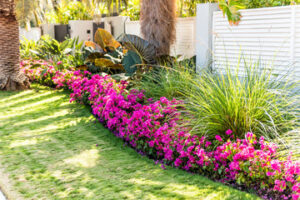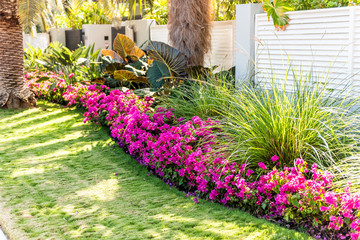Landscaping is the art of creating, modifying and maintaining outdoor spaces. It involves adding plants and altering terrain to enhance beauty, functionality, and sustainability.
Choose Native Plants: These plants are adapted to your climate and soil conditions, so they need less water and fertilizer. Plus, they support local wildlife and ecosystems. Visit https://www.pristinecutslawncarellc.com to learn more.
 It’s often said that a home’s value increases by up to 20% because of its attractive landscaping. However, this number varies depending on the type of landscaping and the size of the property. A large custom home, for example, may be able to command a higher price for its landscape because it has the space and potential for a more complex design.
It’s often said that a home’s value increases by up to 20% because of its attractive landscaping. However, this number varies depending on the type of landscaping and the size of the property. A large custom home, for example, may be able to command a higher price for its landscape because it has the space and potential for a more complex design.
The most important factor in increasing your property value is curb appeal, so it’s vital to invest in a quality landscape. A well-manicured garden and lawn will immediately give potential buyers a positive impression of the home. This is because it shows that the property has been cared for and well-maintained, which in turn will increase its resale value.
Besides curb appeal, other factors that can increase your property value include outdoor living spaces, water features and fire features. In addition, xeriscaping and other sustainable landscaping techniques can help reduce your energy bills. However, the biggest boost to your property’s value comes from its trees and plants. This is because they provide privacy, shade and noise protection for your family.
Enhances Your Quality of Life
Many homeowners find that their outdoor spaces serve as a sanctuary away from the pressure and stress of daily life. The sight of greenery and the sound of a gentle waterfall or stream can reduce anxiety levels. Incorporating a variety of plants and structures can enhance these effects, adding beauty and function to your space.
Landscaping practices help to keep your property safe and healthy by minimizing the growth of invasive plants, trees, or weeds that could potentially damage your home and cause soil erosion. Incorporating native plants can also help improve your soil’s health, as they are adapted to local climate and conditions.
In addition, landscaping can provide a natural privacy screen and buffer noise from nearby roads or neighbors by planting strategically placed plants and trees. Effective water management is also a crucial part of landscaping, as it reduces the need for chemical-based lawn treatments and helps to conserve water and energy.
Attracts Wildlife
Landscaping that attracts wildlife is a great way to get kids and adults outdoors and learning about local animals and ecosystems. Whether you live on a farm or a quarter-acre suburban lot, you can make your property a haven for wildlife by providing the basic habitat components of food, water and shelter. Wildlife-friendly landscaping can be as simple as setting up feeders and bird baths or as complex as restoring a native meadow.
Planting native plants, instead of exotic ornamental species, is the best way to attract wildlife to your yard. Native plants co-evolved with the wildlife that depends on them for survival, and they are adapted to the region’s climate.
Planting ground cover, low shrubs and trees of varying sizes will provide wildlife with the coverage they need to hide from predators or harsh weather. Adding water sources beyond the traditional birdbath will also attract wildlife, such as butterflies and bees that use flowers for nectar or small mammals looking for a drink. Adding a pond, stream, or waterfall to your landscape will attract frogs and dragonflies, as well.
Reduces Stress
Studies show that people who spend time in a well-maintained, aesthetically pleasing garden and yard experience lower levels of the stress hormone cortisol. Gardening and other outdoor activities such as walking among trees, weeding or watering gardens help relieve daily stress and provide an opportunity to learn new skills.
Landscapes can also be natural coolants by blocking sunlight from your home and reducing wind speed. In addition, they can reduce your monthly energy bills by lowering the need for air conditioning and heating.
Landscaping services often include pruning bushes and trees, planting flowers and laying sod, removing debris and mowing the lawn. However, they can also include hardscaping elements such as patios, decks, walkways and fire pits to expand the functional area of your property and create a seamless transition between indoor and outdoor living. Landscaping can also improve your home’s curb appeal, which is an important aspect when preparing to sell. A beautifully maintained lawn and garden can increase the speed at which your home sells and enhance its resale value.
Reduces Noise Pollution
Noise pollution is a major problem for many homeowners, especially those living near busy roads or in densely-populated neighborhoods. Landscaping offers a solution to this issue by absorbing and scattering sound waves. This makes it easier to relax and enjoy your outdoor space.
In addition, studies using EEG and questionnaire surveys have shown that people feel calmer in vegetation scenes than in traffic scenes. The calming effects of green landscapes are thought to be caused by the complex nature of plants and their visual appeal.
For those that live near a busy road, landscaping can be used to create a natural noise barrier by planting dense evergreen trees and hedges. These plants are effective at reducing road noise because they have thick leaves, branches, and bark that effectively absorb sound waves.
Another way to reduce noise pollution is by adding water features to your property. The soothing sounds of trickling water can drown out the constant din of street and highway noise. The calming sounds of water can also attract birds, whose chirping cancels out the noise from human activity.
Increases Your Home’s Energy Efficiency
A well-designed landscaping can help reduce energy costs by lowering heating, cooling, and water usage. It can also contribute to a greener, more sustainable community.
Shade trees and shrubs help keep homes and buildings cooler during summer, reducing the use of air conditioning and saving on electricity bills. Evergreens and other tall plants can act as windbreaks during winter, blocking cold gusts and preventing them from decreasing the warmth of indoor spaces.
Planting deciduous (trees that lose their leaves) trees to shade south and west facing windows and walls in the summer and allow access to sunlight in winter can save on cooling costs. Trees planted to deflect chilly winter winds and to funnel warm summer breezes toward the home can lower heating costs, as well. A combination of these strategies can significantly lower energy costs for commercial and residential properties. Choosing reflective ground cover, like gravel and low-growing flower beds, can bounce natural light around a building, making interior spaces brighter without using artificial lighting. Low-maintenance shrubs and grasses can reduce the energy required for lawn care, further reducing utility expenses.
Reduces Your Water Bills
Landscaping not only makes your property more beautiful, but it can also help reduce your water bills. By utilizing water-efficient irrigation systems, mulching, and planting drought-resistant or native plants, you can minimize your outdoor water usage.
Additionally, installing a windbreak around your home can keep cold gusts from stealing heat that your heating system is working hard to provide. This can significantly cut down on your energy bills in the winter.
When it comes to water conservation, xeriscaping is one of the most effective landscaping methods. This approach to landscape design focuses on water efficiency by grouping plants with similar water requirements, using mulch to retain soil moisture, and designing water-efficient features like rock gardens or natural ponds.
By tracking local weather data and being aware of water restrictions, you can optimize your landscape for maximum water savings. For example, during the summer, you can use a pool cover to reduce evaporation, and install smart sprinklers that adjust their frequency based on the weather. You can also conserve water by using low-flow fixtures, such as faucets and toilets, in your home and office.
Increases Your Home’s Value
A well-designed and maintained landscape adds significant value to your home. It can increase the resale price and speed up the time it takes to sell your house. This is because landscaping provides a first impression that sets the tone for your entire property and makes it more attractive to prospective buyers.
According to the Appraisal Institute, a well-maintained yard can increase your home’s value by up to 17%. It’s important to keep in mind that the value of your landscape depends on how it compares to other properties in your neighborhood.
Some of the best landscaping projects include adding trees, installing walkways and patios, incorporating water features, and installing lighting systems. These improvements are cost-effective and provide a high return on investment. A well-maintained landscape will also enhance your property’s curb appeal, which can attract more potential buyers and make it easier to sell your home in the future.

